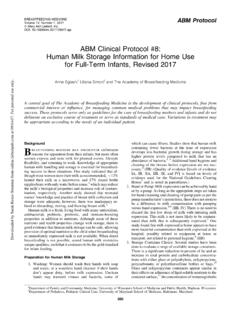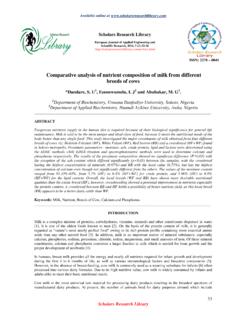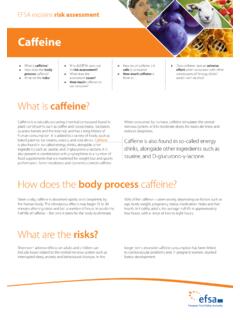Transcription of ABM Clinical Protocol #9: Use of Galactogogues in ...
1 ABMP rotocolABM Clinical Protocol #9: Use of Galactogoguesin Initiating or Augmenting Maternal MilkProduction, Second Revision 2018 Wendy Brodribb and the Academy of Breastfeeding MedicineA central goal of the Academy of Breastfeeding Medicine is the development of Clinical protocols for man-aging common medical problems that may impact breastfeeding success. These protocols serve only as guide-lines for the care of breastfeeding mothers and infants and do not delineate an exclusive course of treatment orserve as standards of medical care. Variations in treatment may be appropriate according to the needs of anindividual (or lactagogues)are medications orother substances believed to assist initiation, mainte-nance, or augmentation of maternal milk supply. Becauseperceived or actual low milk supply is one of the most commonreasons given for discontinuing breastfeeding,1 4both mothersand health professionals have sought medication(s), in addi-tion to other nonpharmacological interventions, to address milk production is a complex physiological processinvolving physical and emotional factors and the interaction ofmultiple hormones, the most important of which is believed tobe prolactin.
2 Despite the fact that prolactin is required forlactation, once lactation is established, there is no direct cor-relation between serum prolactin levels (either baseline levelsor percentage increase after suckling) and the volume of milkproduced in lactating ,6 However, most lactatingwomen have a higher baseline prolactin level than nonlactatingwomen for a number of months and continue to experiencesuckling-induced peaks when is initiated with parturition, expulsion of the pla-centa, and falling progesterone levels in the presence of veryhigh prolactin levels. Systemic endocrine control of other sup-porting hormones (estrogen, progesterone, oxytocin, growthhormone, glucocorticoids, and insulin) is also changes trigger secretory activation (lactogenesis II)of the mammary secretory epithelial cells, also called secretion functionsin a negative feedback system inwhich dopamine serves as an inhibitor.
3 Therefore, when dopa-mine concentration decreases, prolactin secretion from the an-terior pituitary secretory activation has occurred and the mother smilk supply has been established, the rate of milk synthesisis mainly controlled locally in the mammary gland by auto-crine control. Lactating breasts are never completely emptyof milk , so the terms drain, drainage, and draining are moreappropriate. If the breasts are not drained regularly and thor-oughly, milk production declines. Alternatively, more frequentand thorough drainage of the breasts typically results in anincreased rate of milk secretion, with both immediate (perfeeding) and delayed (several days) ,9 Potential Indications for GalactogoguesGalactogogues have commonly been used to increase low(or perceived low) milk supply. Physiologically, low milksupply is often related to suboptimal milk removal withreasons including problems with infants draining the breast,inappropriate breastfeeding management, maternal or infantillness and hospitalization, and regular mother infant sepa-ration, for example, work or school.
4 In addition, galactogo-gues have frequently been used in the neonatal intensive careunit in mothers with preterm infants, where the aim has beento stimulate initial secretory activation or augment decliningmilk secretion. Mothers who are not breastfeeding, but areexpressing milk by hand or with a pump, often experience adecline in milk production after several weeks. Galactogo-gues have also been used in women inducing lactation whenthey have not been pregnant with the current child, in womenrelactating after weaning, or in transgender breastfeeding medicine specialists and lactation con-sultants have recommended various drugs and herbs whenother nonpharmacological measures have not resulted in anincrease in milk volume. However, some providers may in-appropriately recommend Galactogogues before emphasizingthe primary means of increasing the overall rate of milksynthesis ( , frequent and effective milk drainage at regularintervals) or evaluating other medical factors that may poten-tially be involved (see point 1 in the Practice Recommenda-tions section).
5 BREASTFEEDING MEDICINEV olume 13, Number 5, 2018 Mary Ann Liebert, : by Mary Ann Liebert, Inc., publishers from at 09/11/18. For personal use only. Pharmaceutical GalactogoguesHuman growth hormone11 13(lB, llA) (quality of evidence[levels of evidence IA, IB, IIA, IIB, III, and IV] is based onlevels of evidence used for the National Guidelines ClearingHouse14and is noted in parentheses), sulpride15,16(llB), andthyrotropin-releasing hormone17,18(lB) may be helpful asgalactogogues in some populations, but are not currently usedin most countries. Domperidone and metoclopramide are themost commonly used pharmaceutical Galactogogues at pres-ent. Both are dopamine antagonists that increase prolactinsecretion. A number of older mainly observational or con-trolled studies documented increased baseline prolactin levelsin lactating women who took metoclopramide or domperidoneand provide some evidence for their ,20(llA, lll)However, high-quality evidence is lacking.
6 The numbersof women in randomized, placebo-controlled blinded studies(RCTs) with each of these agents are small. Studies alsotended to have high dropout rates, differed in patient selection( , some were expressing for preterm infants, not all womenhad documented low milk supply), and differed in dose andduration of the galactogogue and application of other non-pharmacological measures before starting the studies also had limited Cochrane systematic review21(lA) published in 2012included two studies with a total of 59 mothers with preterminfants and found a moderate benefit (mean increase of 99 mLper day) when using domperidone, 30 mg per day, for 7 or14 days. Other systematic reviews have similar findings,22with the most recent review that included one finding a meanincrease of mL per day (95% confidence interval ).23(lA) There have been four RCTs using domperidonesince the Cochrane review.
7 In one study of 45 women, 22 weregiven domperidone, 30 mg per day, for 4 days postcesareansection and were found to have increased milk productionduring that time compared with the control (lB)In a second study of only 15 women with low milk supplywho were expressing for preterm infants, there was a 300-mLper day difference in milk production for women givendomperidone, 60 mg per day, for 4 weeks compared withwomen given domperidone, 30 mg per day, for a similarlength of (lB) A third trial in the United Kingdomcompared the effects of domperidone, 30 mg per day, withmetoclopramide, 30 mg per day. Women had 24-hour milkproduction measured from 10 days before the commence-ment of medication administration and during the 10 days ofmedication 51 women were expres-sing for their preterm infants and had documented low milksupply. They all received high-quality breastfeeding assis-tance throughout the study.
8 milk production almost doubledfrom the steady premedication level with both medicationsand plateaued after about 7 days of (lB)The fourth and largest trial to date (EMPOWER) included90 women who had low milk supply when expressing forpreterm infants. They were randomized between 8 and 21 dayspostpartum to receive domperidone, 30 mg per day, for 28 daysor a placebo for 14 days and then domperidone, 30 mg per day,from day 15 to 14 days, of women in the firstgroup had increased their milk production by 50% comparedwith in the second group. By 28 days, there were nosignificant differences between the two groups, nor were theredifferences at term or at 6 weeks (lB) The resultsof one older very small study (n=6) suggested that individualwomen may be responders or nonresponders and that pri-miparas may respond to domperidone with higher prolactinlevels than (lB)With respect to potential risks, there is evidence that dom-peridone increases the QTc interval and it has been implicatedin ventricular arrhythmias and sudden cardiac death, particularin older and unwell ,30(lA, lV) The risk for domper-idone to increase the incidence of arrhythmias in postpartumwomen with no other risk factors appears to be very small, butmay increase with other factors such as a past history ofventricular arrhythmias, high BMI, higher dosages, and con-comitant use of medications that inhibit (lll)
9 In thislarge study of more than 225,532 postpartum women, the onlywomen who developed ventricular arrhythmias while takingdomperidone had a past history of ventricular Table 1 for further randomized, placebo-controlled blinded studies re-searching the effect of metoclopramide have been publishedbetween 1980 and 37(lB) Of these, participants inthree studies commenced metoclopramide within 4 days ofbirth without a diagnosis of low milk supply,33,34,37one studyinvestigated women who were relactating,36and one re-cruited women whose infants had not gained 500 g within thefirst month of of these studies found differencesin milk volumes and/or breastfeeding duration between me-toclopramide and placebo groups, even with optimal breastexpression and , as mentioned above,Ingram et similar positive effects with metoclo-pramide and addition, a number of older randomized controlled tri-als,38 41(lB, llA) controlled trials,42,43(llB) and observa-tional studies20,44 46(lll) reported a significant increase inmilk yield using metoclopramide, 5 20 mg, three times aday for periods of 5 days to 4 weeks.
10 The one study thatcompared different doses of metoclopramide found no re-sponse with 15 mg per day, but similar responses with 30 and45 mg per day. The scientific rigor of these older studies maynot be as strong as more recent studies, so their results shouldbe interpreted with caution. As for potential risks, metoclo-pramide may cause neurological side effects in the information can be found in Table the widespread use of these pharmaceutical ga-lactogogues, there are important issues to consider:1. Pharmaceutical Galactogogues do increase baselineserum prolactin, and there is evidence for increasedmilk production with domperidone use (and perhapsmetoclopramide). However, the population that wouldmost benefit from this treatment is still uncertain as itis unknown if all women with low milk supply havelow levels of prolactin and whether increasing pro-lactin increases milk supply in women with both lowand normal prolactin levels.









